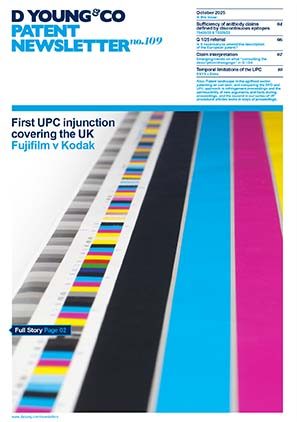Claim interpretation: emerging trends on what “consulting the description/drawings” in G 1/24 may mean
Decisions applying the ruling of G1/24 are now being issued. In this article, we review some of these decisions and highlight the emerging trends which provide useful guidance on consulting the description/drawings for claim interpretation.
Background
The Enlarged Board of Appeal held in G1/24 that the claims are the starting point and the basis for assessing the patentability of an invention and concluded that the description and any drawings must always be consulted to interpret the claims for this assessment and that this requirement is independent of whether the skilled person finds a claim to be unclear or ambiguous when read in isolation (for an in-depth review of G1/24 see our related article “G1/24 practice points: clarity on claim interpretation principles”).
However, there is no specific guidance in G1/24 on how the consultation should be used; this has led to some commentators to assert that the description and drawings can be consulted and disregarded in some circumstances.
Decisions providing some guidance on the ruling in G1/24
The applicant in T1561/23 referred to G1/24 in connection to the disputed interpretations of terms in the claims. Here, the Board of Appeal noted that G1/24 does not define what it means to use the description and drawings in an individual case. In particular, the Board of Appeal highlighted that the requirement from G1/24 to “consult” the description does not even explicitly require that a definition of a term from the description must be used for the interpretation of a claim. The Board of Appeal reasoned, following a consultation of the description and drawings, that in this case it did not justify a narrower interpretation of the wording of the claim.
Citing G1/24, the proprietor in T1069/23 argued that the description and a figure meant that the claim should be interpreted to exclude certain embodiments. The Board of Appeal, however, disagreed and held that there is no reason to deviate from the wording of the claim and cut down its scope by implying into it additional features which appear only in the description of a specific embodiment. The Board of Appeal went on to explain that this is particularly true given that the broader/unrestricted interpretation of the wording of the claim also makes technical sense and is also encompassed by the description as a whole. The Board of Appeal went on to point out that according to the established case law of the Boards of Appeal, only technically illogical interpretations should be excluded.
In T1999/23 the Board of Appeal noted that G1/24 made it clear that the description is to be used when interpreting claims, but otherwise referred to the principles developed by case law. One of these principles is that a restrictive definition of the term in the description may not be used to limit the subject-matter of the claim, which is otherwise clearly broader to the skilled person (See Case Law of the Boards of Appeal, 10th edition, II.A.6.3.4). The Board of Appeal held that this principle remains valid even after decision G1/24 because the Enlarged Board of Appeal in G1/24 had emphasised that interpretation begins with and is based on the claims. As a consequence, the Board of Appeal found that the patentee had created ambiguity by the inconsistent use of a term, with the term in the claim being without restriction, and the term in the description with a restriction that is unusual for the subject. The Board of Appeal held that there is no objective reason why a patent proprietor should be allowed to deviate from the established technical terminology in the formulation of the subject-matter, the use of which third parties are to be excluded, without any discernible justification and to refer to this only in the description. The Board of Appeal held that a glance at the description merely reveals that there is a conceptual deviation from the common technical terminology in the description, which is not reflected in the claim. Resolving this ambiguity to the detriment of the party who created it without objective necessity is consistent with the principle of legal certainty and the primacy of the patent claims as affirmed in decision G 1/24. T1465/23 confirms T1999/23 and notes that the disputed terms in this case typically have a stable and well-understood meaning; therefore these terms are not to be re-interpreted or understood in a more limited way in the light of the specific embodiments of the patent description, which, in addition, contain subject matter that is more limited than that claimed.
The Board of Appeal in T2027/23 provides a comprehensive commentary on G1/24. In this case, the patentability of the claims was dependent on whether the claims could be interpreted narrowly in the light of the description. The patentee argued that “consulting” the description and drawings meant the definitions of a claim feature provided in the description and drawing should be read into a claim. The Board of Appeal however, disagreed and went on to identify the following three major takeaways from G1/24:
- The wording of the claims forms the “basis” for its interpretation and, for the purpose of interpreting the claims, the description and the drawings should always be “consulted” or “referred to”. The Board of Appeal noted that G1/24 is silent as to purpose of the “consultation” or “reference”.
- Discrepancies in claim interpretation practice between national courts, the Unified Patent Court (UPC) and the Boards of Appeal are undesirable and should thus be avoided.
- It is up to a patentee to remedy discrepancies between the description and the claims.
The patentee further argued that a feature of the claim must be interpreted in a more limited manner based on features set out in the embodiments of the invention as disclosed in the patent description. The Board of Appeal, however, held that it found no authority for interpreting a claim more narrowly than the wording of the claim as understood by the person skilled in the art would allow for the following reasons:
- “Consulting the description” does not imply any specific result of such consultation: a consultation of two conflicting authorities does not a priori determine who is master. Decision G1/24 does not require the Boards of Appeal to give the description preference over the wording of the claim. To the contrary, according to G 1/24, “the claims are the starting point and the basis for assessing the patentability of an invention”. The Board of Appeal added that the claims are the “decisive basis”.
- Such an interpretation would contradict the well-established jurisprudence of the Boards of Appeal.
- Such an interpretation would directly contradict the second takeaway from G1/24.
The Board of Appeal concluded that in order to do justice to the second takeaway from G1/24 decision and align the judicial practice of the Boards of Appeal with that of the national courts and the UPC, a claim should not be interpreted, based on features set out in embodiments of an invention, as having a meaning narrower than the wording of the claim as understood by the person skilled in the art. The Board of Appeal further pointed out that in cases of discrepancy between the claim language and the description, it falls upon the patentee to remedy this incongruence by amending the claim and that it is not the task of the Boards of Appeal to reach such alignment by way of interpretative somersaults.
Takeaways & practice points
A common theme of the above decisions is that the parties had tried to use definitions from the description to narrow the meaning of the claims.
The Boards of Appeal in these decisions acknowledge that G1/24 is silent as to the purpose of consulting the description/drawings. Notably, the above decisions highlight that there is no requirement in G1/24 for the Boards of Appeal to give the description preference over the wording of the claim. Further, these Boards of Appeal showed that they were willing to follow existing European Patent Office (EPO) claim interpretation jurisprudence. Specifically, there is no reason to interpret a claim more narrowly than the wording of the claim as understood by the person skilled in the art would allow, such as by implying into it additional features which only appear in a specific embodiment in the description. In particular, it is highlighted that where there is a discrepancy between the claim language and the description then it is up to the patentee to remedy the situation by amending the claim.
Additionally, the Board of Appeal in T2027/23 confirms that harmonisation on claim interpretation practice between the Boards of Appeal and the national courts and the UPC is desirable. However, some commentators consider that UPC case law is placing a greater emphasis on the description than the case law being developed by the EPO Boards of Appeal; for example, the UPC Court of Appeal in NanoString Technologies Inc v 10x Genomics Inc (UPC_CoA_335/2023) sets out the principle that the description and drawings must always be used as explanatory aids for interpretation, not just to resolve any ambiguities in the claim language, such that only after examination of the description and drawings does the scope of the claims become apparent.
Summary
In these decisions there has been no divergence from existing EPO case law on claim interpretation after G1/24. The decisions discussed re-affirm the need to ensure definitions in the description are consistent with terms in the claims.
It will be interesting to see how this area of EPO case law develops in light of G1/24 and what divergences, if any, from the existing body of EPO case law emerge. In particular, we eagerly await the resolution of the key issue in T0459/22 (the referring decision of G1/24), namely: the impact of a term used in the claim having a broader meaning in the description than the meaning normally assigned to the term.
Related articles
- G1/24 practice points: clarity on claim interpretation principles: dycip.com/g124-claim-interpretation
- Claim interpretation: more clarity on claim construction at the UPC, 12 June 2025: dycip.com/upc-claims-agfa-insulet
G 1/24 decision
Jurisdiction: EPO
Decision level: Enlarged Board of Appeal
Parties: Philip Morris Products SA (applicant) and Yunnan Tobacco International Co Ltd (opponent)
Citation: G1/24
Date: 18 June 2025
Decision: dycip.com/epo-g1-24
Related Technical Board of Appeal decisions
- T1561/23, time monitoring function, 23 June 2025: dycip.com/epo-t1561-23
- T1069/23, disposable wearable article, 01 July 2025: dycip.com/epo-t1069-23
- T1999/23, photothermal measuring device), 18 July 2025: dycip.com/epo-t1999-23
- T1465/23, isolated islands of cryptography, 24 June 2025: dycip.com/epo-t1465-23
- T2027/23, turnable ladder, 30 June 2025: dycip.com/epo-t2027-23

